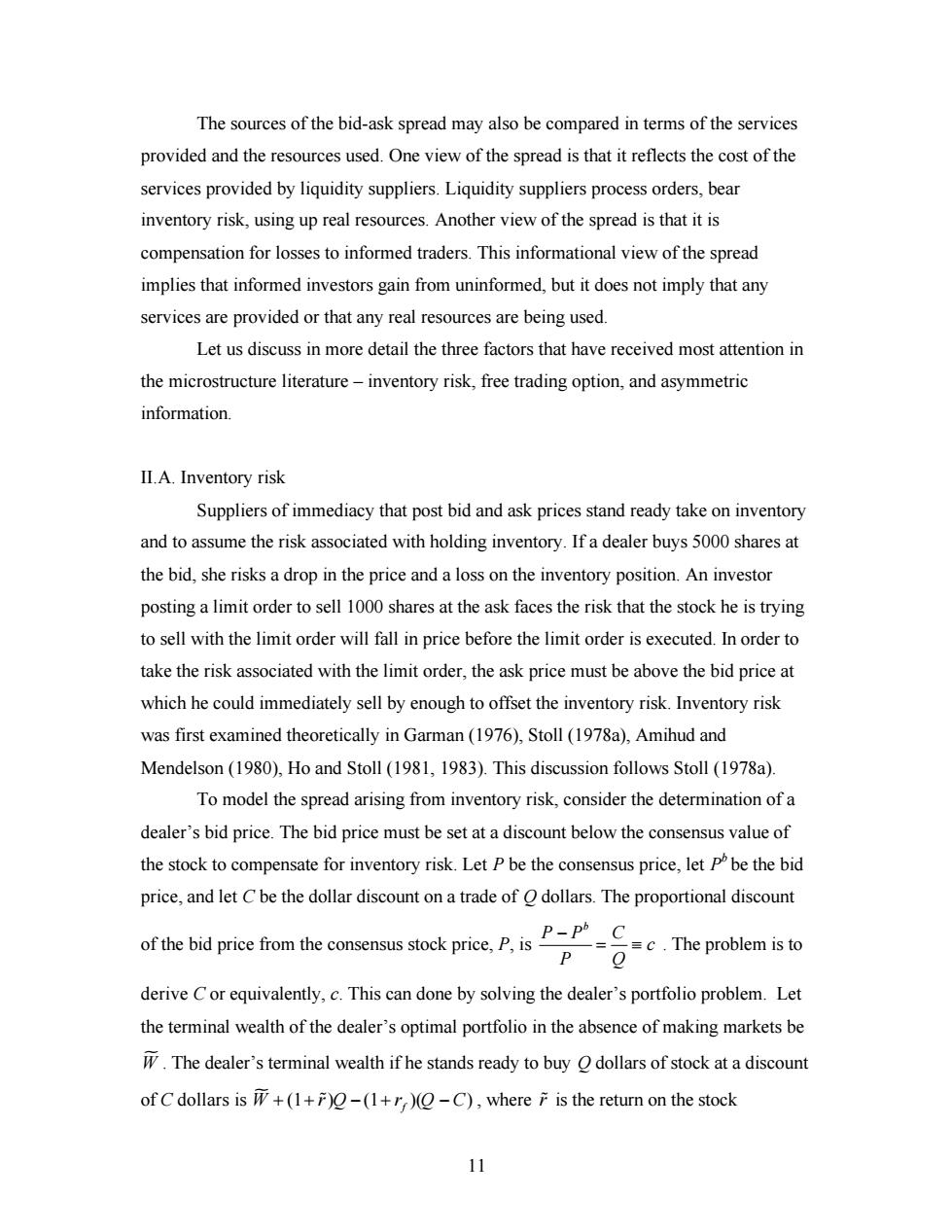正在加载图片...

The sources of the bid-ask spread may also be compared in terms of the services provided and the resources used.One view of the spread is that it reflects the cost of the services provided by liquidity suppliers.Liquidity suppliers process orders,bear inventory risk,using up real resources.Another view of the spread is that it is compensation for losses to informed traders.This informational view of the spread implies that informed investors gain from uninformed,but it does not imply that any services are provided or that any real resources are being used. Let us discuss in more detail the three factors that have received most attention in the microstructure literature-inventory risk,free trading option,and asymmetric information. II.A.Inventory risk Suppliers of immediacy that post bid and ask prices stand ready take on inventory and to assume the risk associated with holding inventory.If a dealer buys 5000 shares at the bid,she risks a drop in the price and a loss on the inventory position.An investor posting a limit order to sell 1000 shares at the ask faces the risk that the stock he is trying to sell with the limit order will fall in price before the limit order is executed.In order to take the risk associated with the limit order,the ask price must be above the bid price at which he could immediately sell by enough to offset the inventory risk.Inventory risk was first examined theoretically in Garman (1976),Stoll(1978a),Amihud and Mendelson(1980),Ho and Stoll(1981,1983).This discussion follows Stoll (1978a). To model the spread arising from inventory risk,consider the determination of a dealer's bid price.The bid price must be set at a discount below the consensus value of the stock to compensate for inventory risk.Let P be the consensus price,let pbe the bid price,and let C be the dollar discount on a trade of O dollars.The proportional discount of the bid price from the consensus stock prieeisC =c.The problem is to P O derive Cor equivalently,c.This can done by solving the dealer's portfolio problem.Let the terminal wealth of the dealer's optimal portfolio in the absence of making markets be W.The dealer's terminal wealth if he stands ready to buy dollars of stock at a discount of C dollars is W+(1+)-(1+)(O-C),where is the return on the stock 1111 The sources of the bid-ask spread may also be compared in terms of the services provided and the resources used. One view of the spread is that it reflects the cost of the services provided by liquidity suppliers. Liquidity suppliers process orders, bear inventory risk, using up real resources. Another view of the spread is that it is compensation for losses to informed traders. This informational view of the spread implies that informed investors gain from uninformed, but it does not imply that any services are provided or that any real resources are being used. Let us discuss in more detail the three factors that have received most attention in the microstructure literature – inventory risk, free trading option, and asymmetric information. II.A. Inventory risk Suppliers of immediacy that post bid and ask prices stand ready take on inventory and to assume the risk associated with holding inventory. If a dealer buys 5000 shares at the bid, she risks a drop in the price and a loss on the inventory position. An investor posting a limit order to sell 1000 shares at the ask faces the risk that the stock he is trying to sell with the limit order will fall in price before the limit order is executed. In order to take the risk associated with the limit order, the ask price must be above the bid price at which he could immediately sell by enough to offset the inventory risk. Inventory risk was first examined theoretically in Garman (1976), Stoll (1978a), Amihud and Mendelson (1980), Ho and Stoll (1981, 1983). This discussion follows Stoll (1978a). To model the spread arising from inventory risk, consider the determination of a dealer’s bid price. The bid price must be set at a discount below the consensus value of the stock to compensate for inventory risk. Let P be the consensus price, let P b be the bid price, and let C be the dollar discount on a trade of Q dollars. The proportional discount of the bid price from the consensus stock price, P, is b P P C c P Q - = º . The problem is to derive C or equivalently, c. This can done by solving the dealer’s portfolio problem. Let the terminal wealth of the dealer’s optimal portfolio in the absence of making markets be W° . The dealer’s terminal wealth if he stands ready to buy Q dollars of stock at a discount of C dollars is ° (1 ) (1 )( ) W f + + r% Q - + - rQC , where r% is the return on the stock